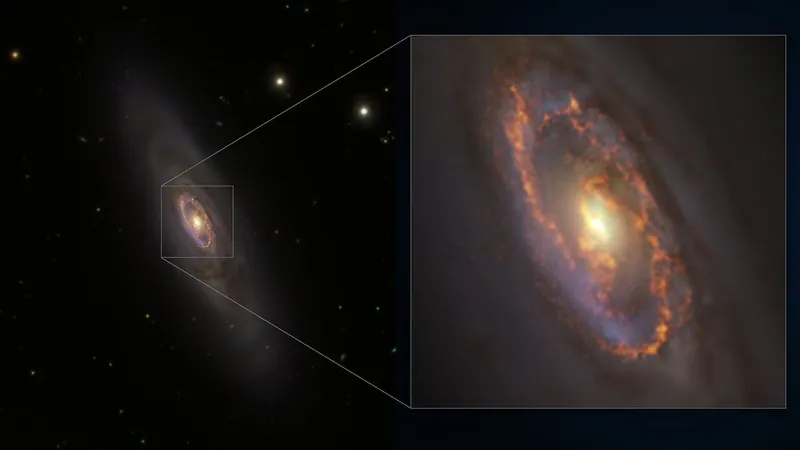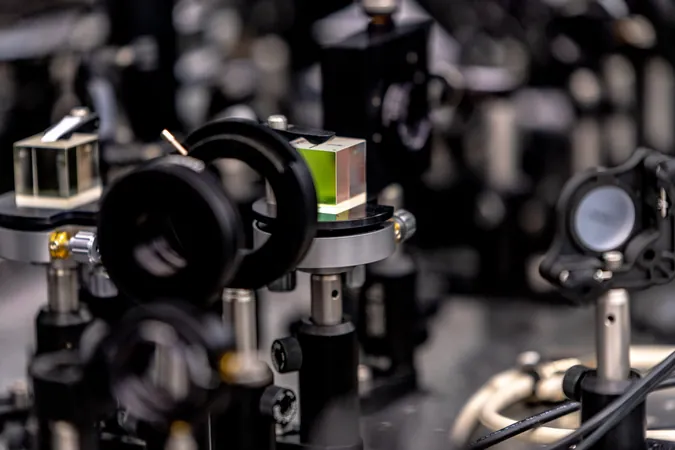
Groundbreaking Discovery: Astronomers Unveil Synchronized Star Formation in Ancient Galaxy for the First Time!
2024-11-05
Author: Arjun
Groundbreaking Discovery: Astronomers Unveil Synchronized Star Formation in Ancient Galaxy for the First Time!
In an astonishing astronomical breakthrough, scientists have uncovered thousands of young stars clustered tightly around the core of an ancient galaxy—this remarkable formation occurred nearly simultaneously just 4 million years ago! This unprecedented observation challenges long-held beliefs about how star formation diminishes as galaxies age.
About the Ancient Galaxy NGC 1386
The ancient galaxy in question, NGC 1386, is a stunning spiral galaxy located approximately 53 million light-years away in the constellation Eridanus. A research team, spearheaded by Almudena Prieto from Spain's Instituto de Astrofísica de Canarias, has identified 61 groups of young stars. These clusters are uniquely positioned in a striking blue ring, which spans about 1 kiloparsec in width, suggesting a shared origin of their formation.
Synchronized Star Formation
Prieto remarked, "All of these clusters are distributed like pearls on a ring around the center of the galaxy. Surprisingly, they are all alike, indicating they were created at the same time in a synchronized event." This synchronization of cosmic creation is nothing short of revolutionary, as it flips the narrative on galactic development.
Observation and Findings
Using the powerful Hubble Space Telescope along with the VLT Survey Telescope in Chile, the team observed that these blue star clusters are nourished by lengthy filaments of gas and dust. This material, crucial for star formation, travels from the galaxy's outer disks to its central regions, enabling this cosmic burst of activity.
Absence of Neighboring Galaxies
Interestingly, no neighboring galaxies were found in the vicinity of NGC 1386, leading researchers to conclude that these gas filaments are likely the sole source of the star-forming material for the galaxy. This offers compelling evidence that, against previous assumptions, some older galaxies can still experience vigorous star formation.
Ongoing Star Formation
Prieto stated, “Even now, this galaxy has organized itself to acquire the needed supplies from its outer zones, within its stellar disk.” This poses a vital question in astrophysical research: What events triggered such a synchronized formation? The research paper published in the Monthly Notices of the Royal Astronomical Society posits that a significant event within the galaxy’s disk—a density wave—may have compressed gas and ignited this spectacular formation of clusters.
Implications and Future Possibilities
But the excitement doesn't stop there! This team also revealed the existence of a second, golden ring encircling the galaxy's center, containing around 70 identical pockets of gas, implying that NGC 1386's star-forming capabilities are far from exhausted. The researchers speculate that another wave of synchronized star formation may be on the horizon, potentially occurring in the next 5 million years.
Conclusion
The implications of this discovery are monumental. As Prieto aptly notes, "Even though it is ancient, NGC 1386 continues to rejuvenate itself." This research challenges the conventional wisdom of galactic evolution and opens new avenues for understanding the life cycles of galaxies. Stay tuned, as the cosmos has more surprises in store!


 Brasil (PT)
Brasil (PT)
 Canada (EN)
Canada (EN)
 Chile (ES)
Chile (ES)
 España (ES)
España (ES)
 France (FR)
France (FR)
 Hong Kong (EN)
Hong Kong (EN)
 Italia (IT)
Italia (IT)
 日本 (JA)
日本 (JA)
 Magyarország (HU)
Magyarország (HU)
 Norge (NO)
Norge (NO)
 Polska (PL)
Polska (PL)
 Schweiz (DE)
Schweiz (DE)
 Singapore (EN)
Singapore (EN)
 Sverige (SV)
Sverige (SV)
 Suomi (FI)
Suomi (FI)
 Türkiye (TR)
Türkiye (TR)